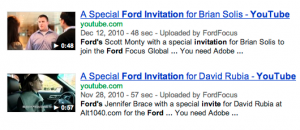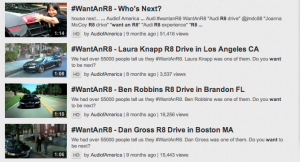Lessons From The Auto Industry: Leveraging Social For Organic Traction
Links are not often thought of as a by-product of a great social campaign. Often the goals of those working on social profiles for a brand revolve around a simple goal: Getting more followers and building an audience. This is a strong goal that makes sense, but rather short sighted. There’s more to social than […]
Links are not often thought of as a by-product of a great social campaign. Often the goals of those working on social profiles for a brand revolve around a simple goal: Getting more followers and building an audience.
This is a strong goal that makes sense, but rather short sighted. There’s more to social than simply having a sounding board. If you leverage your fans and followers correctly, they’ll be your key to naturally generating links and mentions around your brand.
The big question is: I’ve built up these social channels. Now, how do we take advantage of successful social media profiles to help us perform better organically?
All of the below advice will need to be tailored to your brand, product, or market, but for this piece, we’ll start with dissecting one industry that’s been moving year after year into the social spotlight.
The Auto Industry
The auto industry, on a local level, is extremely competitive. Depending on your city, there could be local brick and mortars that are hogging up the local 7 pack, not to mention competition with high authority domains like Cars.com.
Unless you’re leveraging multiple advertising channels, chances are, you’re losing business to the bigger guys when it comes to users who are “window shopping” online.
The days are gone when you can simply create press releases and send them out to every free and paid wire out there. Even though the car manufacturers have a sky-high budget for advertising and marketing, there are more “grass roots” ways to encourage link generation through your social channels.
- Build your Audience. A bigger (targeted) audience equals more eyeballs, which can translate into content being linked to and shared outside of the network on blogs and publications.
- Link Generation. Social media can be leveraged for link generation because of the exposure and reach social networks can provide. Sharing content through highly trafficked social channels can spark coverage outside the network as well.
- Personalization. Fans and consumers love to feel like they’re the “only one” you’re brand is marketing to. Social channels allow for personalization and cross-pollination opportunities when running campaigns.
- Do something unexpected. Unexpected uses of social can garner mentions and links from high quality publications
- Collect your Data. No matter how big or small you are in your industry, there’s always the opportunity to put simple measure into place to track increases in audience, engagement, newsletter signups, social referrals and ranking improvements over time. This makes great case study data.
- Leverage Outreach. To follow up on the previous point, if you’re using social in an unexpected way, share your case study data with publications that have a tendency to share content around innovative social usage. Outreach can help you gain more personalized exposure that trumps a press release.
I pulled a quick snapshot of some of the big car brands to see what their social visibility was across the space.

Searchmetrics Car Snapshot
Let’s look at what Ford and Audi are doing in the space. I want to focus on both because I’m familiar with campaigns they’ve run in the past, and while Ford has extremely high social visibility, Audi has had some long, ongoing social campaigns that have generated link and publicity over time.
[Dislaimer: I am in no way affiliated with any of the brands mentioned below.]
Ford: Saves Reveals for Specific Social Audiences
Ford tends to do reveals on their Facebook page. They do have a big enough audience where it reaches a ton of eyeballs and gets shared, but more importantly, the way they’re approaching the reveals has attracted attention from third party publications who cover the unique way the’yre choosing to do it.
They’re letting the audience make an impact and breed exposure by doing something unexpected. When the audience creates a large enough movement, and enough buzz, others outside the social networks take notice.
Audi: Leaking Videos Via Facebook
I first remember noticing that Audi was really taking advantage of the Web when I saw the Green Police commercial that aired during the Superbowl in 2010.
They decided to leverage their fan page during that time to “leak” the video and provide a sneak peak to their existing fans prior to the real video launch. This tactic was great for link generation because at that point in time, leveraging Facebook in that way was still relatively “new.”
Admittedly, this is a poor example because many businesses (okay, the majority of businesses) don’t have the money to air a Superbowl commercial. It’s more about the technique behind it.
- Smaller Scale Tactic: Do something unexpected. If you’re studying how your competitors (either brick and mortar, or strictly online) are revealing new products and announcements, try leveraging your social channels for specific ones. If you’re a brick and mortar and you have a location page tied to your Google+ page, try encouraging users to add your brand to their circles and participate in a hang out where you reveal “something secret” that other channels won’t get.
- Promote the hangout with local publications and offer special incentives for sharing with their audience. There’s a fine line here between willingly participating, and requiring a website to write about your company. Make sure any disclosure is followed if they’re offering discounts to their audience on your company’s behalf.
Ford: Using Social To Ignite Offline Events
Ford used personalized YouTube invitations to directly target some high profile bloggers, writers and other VIPs to come test drive a Ford Focus in Spain. Their technique was simple: create a very personalized message for each blogger/person, and drive them to sign up on their Facebook page.
The tailored, unique approach to each invitation and the time spent on the campaign was smart and gained coverage across multiple general publications and car publications. While smaller auto shops won’t have the budget to spend on techniques like that, you can carry the spirit of the idea into something that works for you.
Smaller Scale Tactic 1: Personalization is key in a huge social audience. If you’re targeting bloggers or followers in a personalized way, there’s a good chance that they’ll be more receptive to participating with, and sharing, your brand.
Smaller Scale Tactic 2: Using social channels as means for inviting bloggers or social followers to offline events is a great way to gain coverage and press within local blogs to create strong geo signals. If you have a new car model come in (for instance, when a local Audi dealer gets an R8 in the showroom), you could throw an event for local car clubs and auto bloggers, with the chance for one of them to test drive it.
You can reach out to local press and small local publications to cover the event and use of social media in your town. Tampa covers events like this all the time.
One Audi dealership here in Tampa throws VIP events where they bring in old historic Audi race cars and brands. They share the event across all their social channels and in real life too. These events are relatively easy for a medium sized car dealership to throw and great for buzz generation.
Audi “Want an #R8” Twitter Campaign
Normally I don’t pay attention to contests on social media. What’s great about the “Want an #R8” campaign is that they’re reaching an engaged audience on their social networks – much of whom admire the Audi brand but are too young to afford one – and use that as a channel to generate links and content on other mediums.
The campaign generated buzz outside of Twitter and caught the attention of publishers. Audi was also cross-pollinating with different pieces of the contest on different channels. When someone actually won the rights to have an R8 for the weekend, it was captured on video and shared on their YouTube channel to encourage brand trust and excite their fan base.
From there, the contest was shared and spread across multiple channels to eventually generate links and buzz from topically relevant sites, as seen below.
Smaller Scale Takeaway: They have made great use of an evergreen hashtag. If you’re looking to hold any local events or tweet ups, identify a hashtag that’s relevant to your event and make sure you use it on all your online collateral. If you are holding a tweet up, or physical meetup/event for local bloggers and social media followers local to you, encourage the use of media. While Audi chose to share its media on YouTube, make sure you have albums readily available for users to share and upload geo-tagged media to.
Smaller Scale Takeaway: Glamorize. If you think about it, most people can walk into a dealership, sign some papers and test drive an R8. What made this campaign so unique was the high profile sharing, the competition to drive one, and gaining the attention of the brand by winning. If you’re holding a local test drive event, go big.
Turn it into a large event. Encourage social check-ins. Contact local publications and make them aware of the event. Work on getting natural coverage by pumping up the event and exposing it to those who are influencers locally and online.
Key Takeaways
I could go on sharing campaigns that the big guys in the auto industry have launched that helped gain effective organic traffic that goes beyond typical press release and content strategies.
If you’re looking to really have a social strategy that compliments your goals in the organic space, you have to have a UVP [unique value proposition] in the social space that encourages others to share your brand and your campaigns.
Social media can absolutely be used to gain traction organically if you leverage your community correctly and give them something to talk about.
Both of these brands in the auto industry have done an excellent job of using social channels to bring the discussion outside of those networks and in the hands of publishers. I’m a huge fan of Audi. They’ve been taking complete advantage of the social space, and even though they’re in a space where they have strong brand recognition, what they’re doing in social spans beyond “social media marketing.”
It’s helping them gain ground from an organic and PR perspective, and also reaching a level of consumers (like me) who may not have had the brand on the top of their minds.
In other words, they’re reaching a huge audience through social, but generating links while doing so.
When trying to expand your reach and cross the line from social to organic, personalize, glamorize, publicize, and do something unexpected. You need to give others something to talk about.
Contributing authors are invited to create content for Search Engine Land and are chosen for their expertise and contribution to the search community. Our contributors work under the oversight of the editorial staff and contributions are checked for quality and relevance to our readers. The opinions they express are their own.
Related stories
New on Search Engine Land







